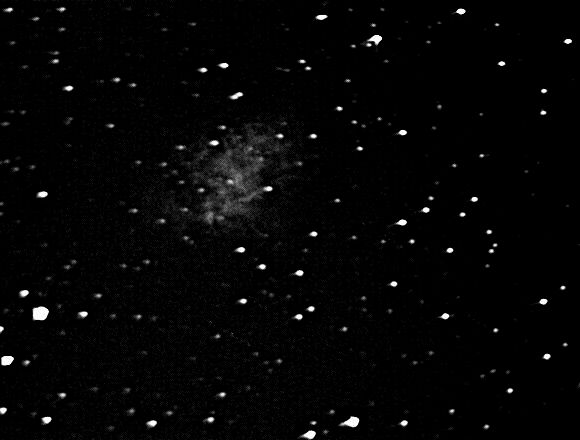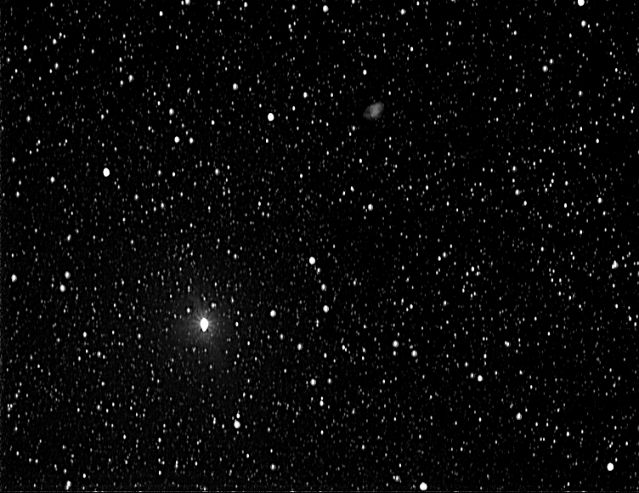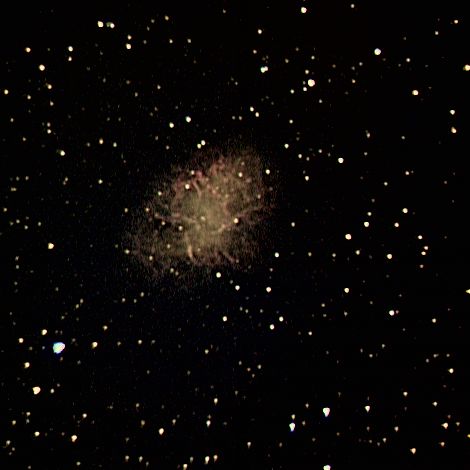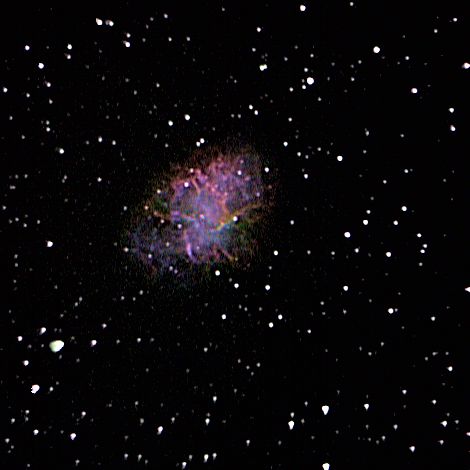 |
This is my first attempt at this nebula. It is magnitude 8.4 with a surface brightness of 11.0.
Date and Time: 7th January 2007 21:39 UT
Camera: Atik ATK1 HS
Telescope: LX200 with 0.33 focal reducer (focal length 800 mm)
Capture: K3CCDTools. Low gamma, exposure 10 sec, 100% gain, 79 frames
Processing: K3CCDTools. 34 frames stacked.
Registax. wavelets 2-4 = 10, gamma curve
PhotoImpact. Brightness -39  |
|

|
Here is M1 in its setting in the sky. It was taken with my 135 mm SLR lens. If you move your mouse over the image you will see some of the stars identified with their magnitudes and also, to give it scale, an image of the full Moon taken with the same optics.
Date and Time: 20th February 2010 19:12 to 20:51 UT
Camera: Starlight Xpress MX716
Telescope: 135 mm SLR lens
Capture: Star_mx7. Exposure 60 sec, 88 frames
Processing: Star_mx7. Background, non-linear stretch (factor 25), background.
Registax5. 74 frames stacked, wavelets 1-2 = 5, gamma 1.4, histogram 12-255 |
|

|
And now a colour image produced with the LRGB technique. In addition to the post processing listed below, the L image was enhanced with wavelets 1,2 = 5 and the contrast increased to 20 in PhotoImpact. The four images were aligned in Registax before being combined in Photoshop to produce the LRGB image. The saturation was increased slightly in PhotoImpact to yield the final image
Date and Time: 24th October 2010 03:58 to 04:39 UT
Camera: Starlight Xpress MX716
Telescope: LX200 with 0.33 focal reducer and Astronomik CLS and RGB filters
Capture: Star_mx7. Exposure 60 sec, 10 frames for L, 5 each of R, G, and B
Processing: Star_mx7. Background, non-linear stretch (factor 25), background.
Registax5. All frames stacked, gamma 1.5, histogram 20-255 |
|

|
At the same time I took the picture above, I also made one exposure each using the narrow-band, Hα, OIII, and SII filters. Using the Hα as red, the OIII as green, SII as blue, and the same L image I used above, I assembled this LRGB picture. The OIII emission was much weaker than the other two as can be seen by the comparative lack of green in the picture. Click on the picture to see the individual frames.
Date and Time: 24th October 2010 04:42 to 04:47 UT
Camera: Starlight Xpress MX716
Telescope: LX200 with 0.33 focal reducer and Astronomik filters
Capture: Star_mx7. Exposure 60 sec, 1 frame each
Processing: Star_mx7. Background, non-linear stretch (factor 25), background.
|

